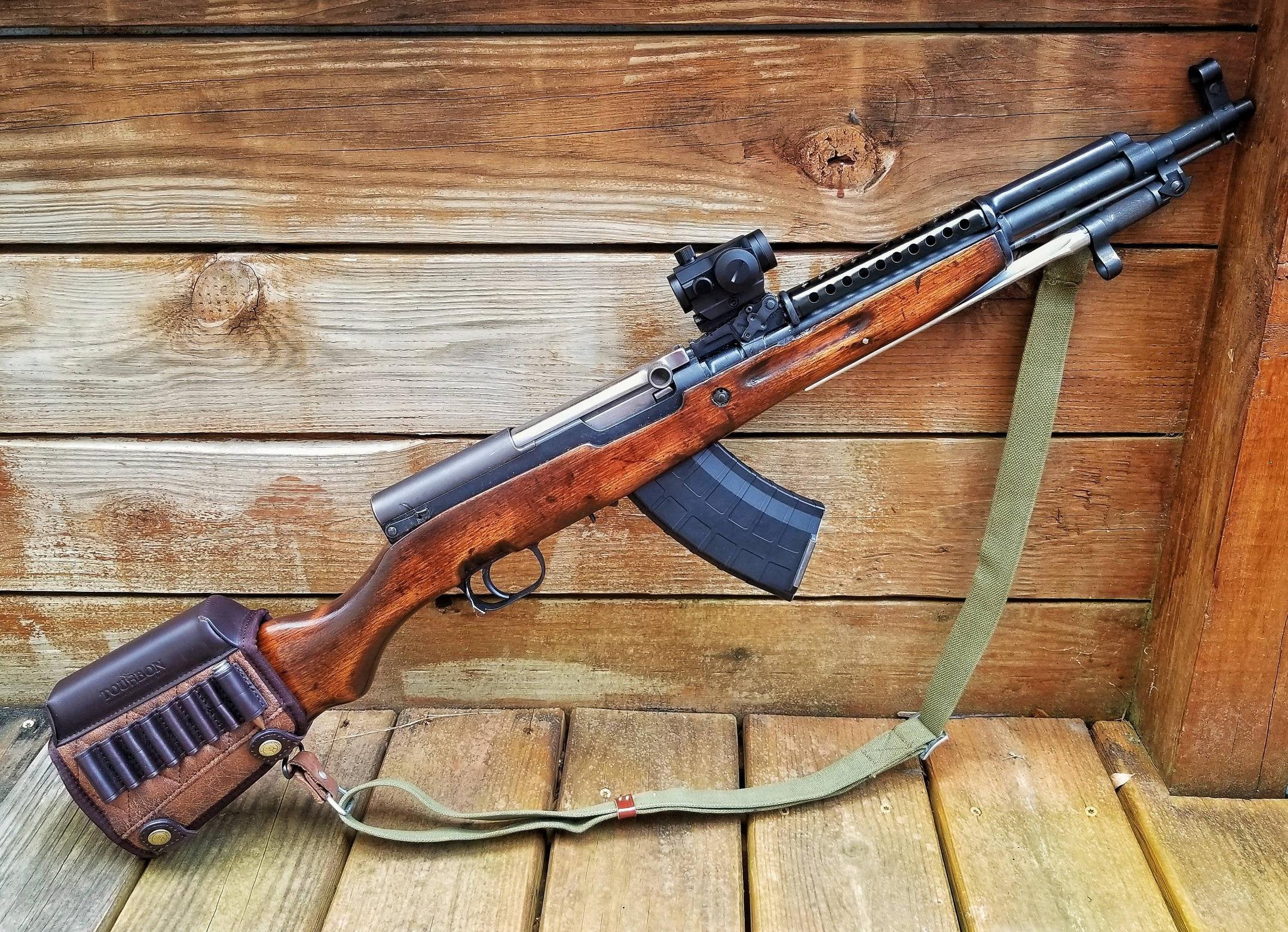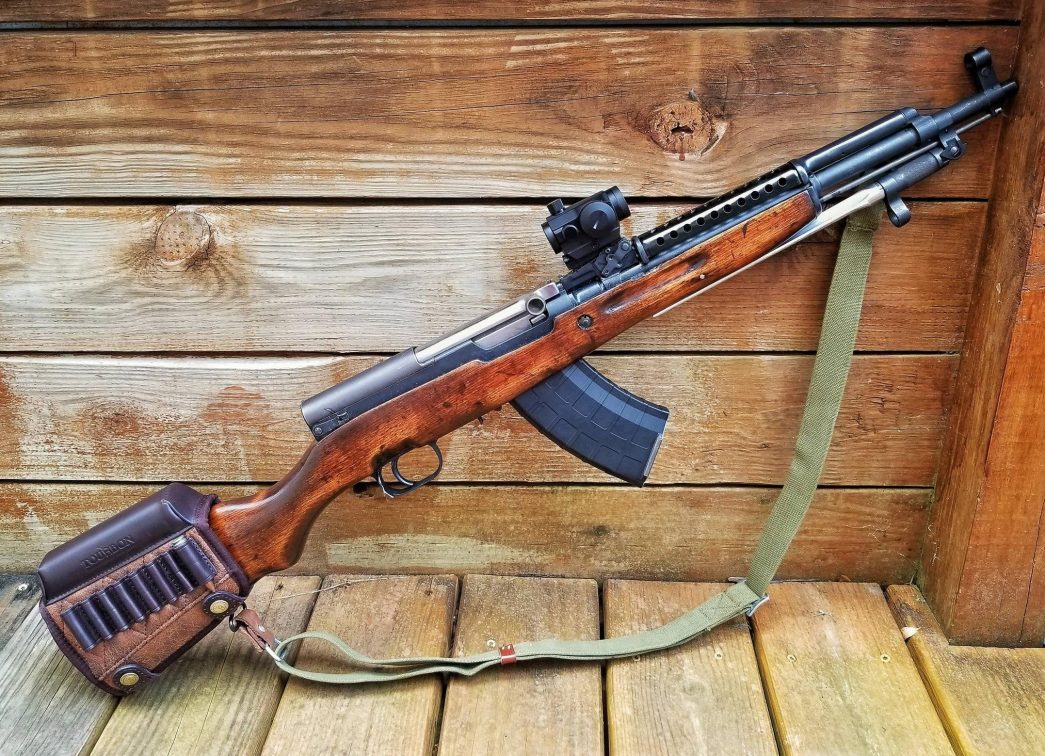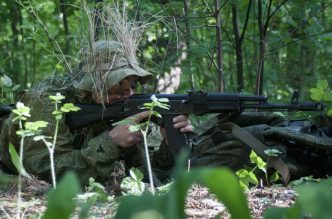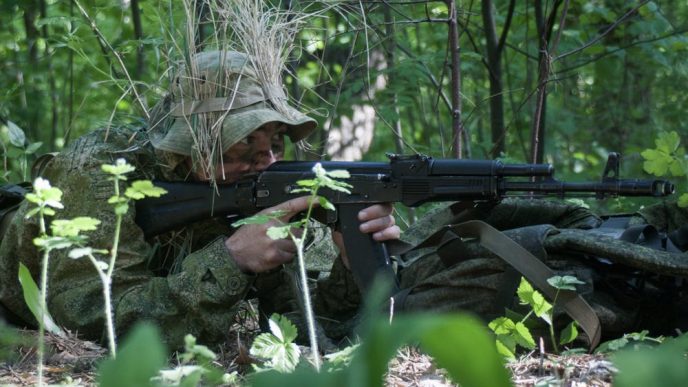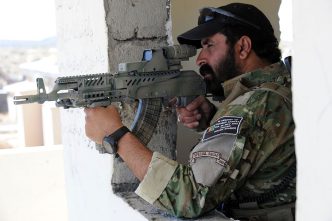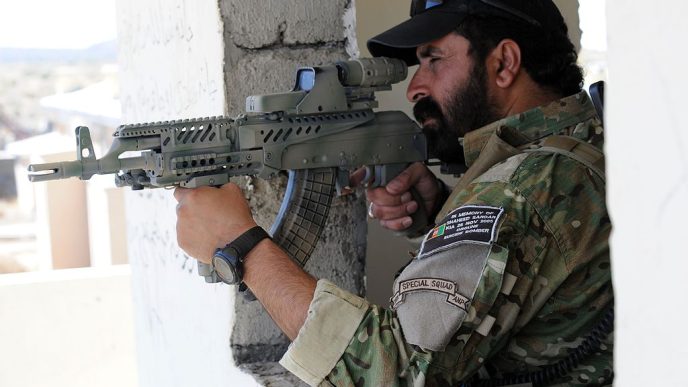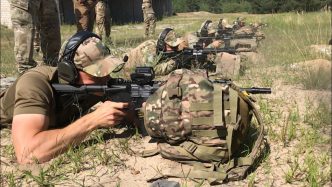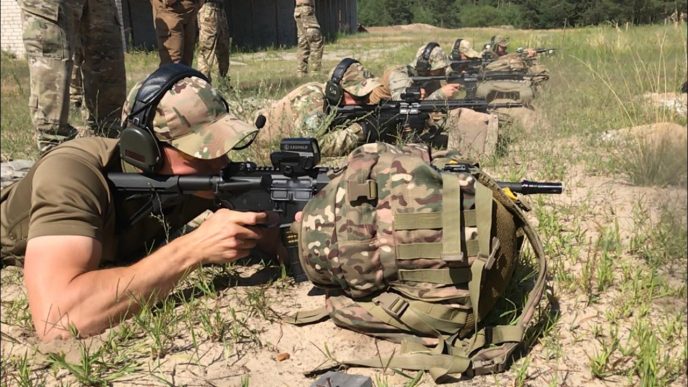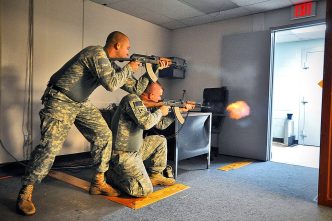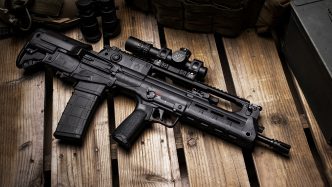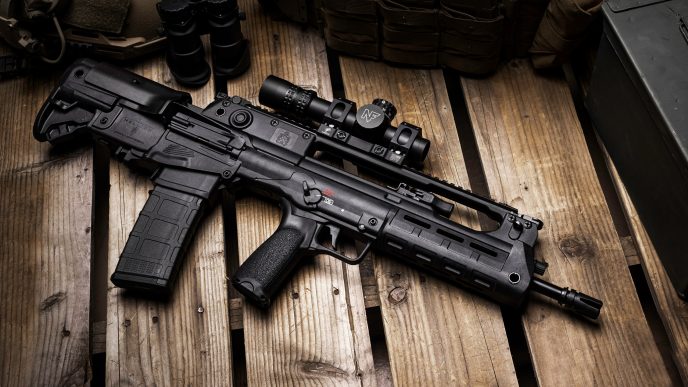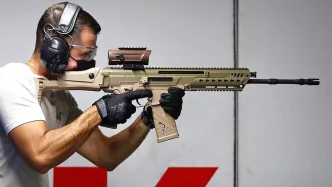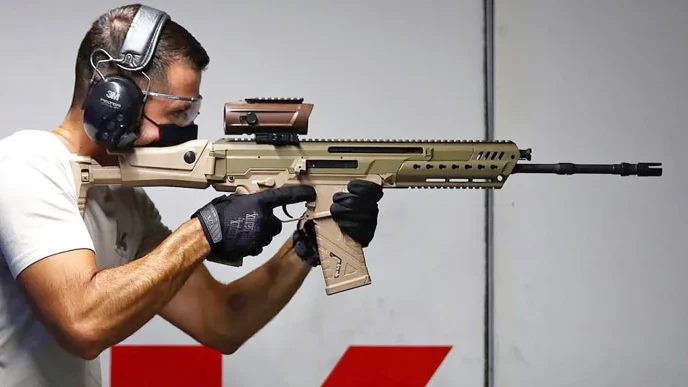Estimates vary, but there may be as many as 2 million SKS rifles in the US; about 950,000 were imported in 1993 alone. The SKS was one of the most common foreign firearms designs in the US during the 1990s.
Introduction
The SKS was adopted by the Soviet Union in 1946 and is the basis for the later AK series of weapons. It is a gas-operated, semi-automatic rifle and might be referred to as a miniature version of the 14.5mm PTRS semi-automatic antitank rifle used during World War 2. The SKS and the PTRS were designed by the famed Russian arms inventor Sergei Simonov. Because of its light recoil and moderate weight, SKS can achieve 35 rounds per minute of aimed fire.
Unlike its predecessor, the Tokarev, the SKS features an instantly dismountable gas system. The gas cylinder is an integral part of the handguard and contains the piston rod. The front end of the combined gas cylinder and handguard fits over a gas port housing pinned to the barrel approximately 7 inches from the muzzle. The rear end butts against the rear sight base, containing the tappet rod and tappet rod return spring. The latch located on the right side of the sight locks the handguard-gas cylinder into place. Its removal for field maintenance takes less than three seconds.
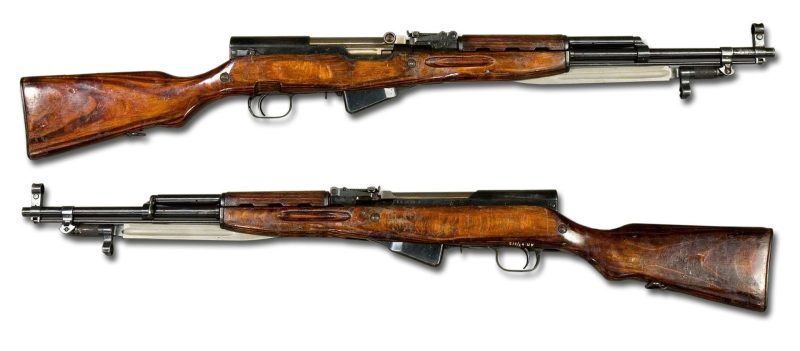
In the 1950s, Soviet technical advisors helped the Chinese government establish several factories to produce the SKS carbine. The first Chinese SKS carbines were identical to their Soviet counterparts and were adopted by the Peoples Republic of China as the Type 56 carbine. Subsequently, the Chinese have manufactured several varieties of the original SKS, including selective-fire models, short-barreled “paratrooper” models, and models which use the detachable magazine of the later AK-47 assault rifle.
As the general availability of the AK-47 improved in the early 1960s, the SKS was relegated to the category of a secondary military arm in both the USSR and the PRC. However, stockpiles of millions of SKS carbines are maintained for the “Peoples Militias” (strategic reserve) and exported to the third world countries as “military aid.”
Design
When the rifle is fired, gas enters the gas port housing pressure to thrust the piston rod back against the short tappet rod. In moving around, the tappet rod slides through a hole in the rear sight base and a corresponding one in the top of the receiver to strike the bolt carrier.
The claw-like arrangement of the bolt carrier cams the rear end of the bolt upward, unlocking it ultimately after 7/16″ of rearward travel. The kinetic energy imparted to the bolt carrier upon being struck by the tappet rod is sufficient to cause the bolt and bolt carrier to travel together 3 7/8″ rearward to extract and eject the fired case and to compress the recoil spring.
The compressed recoil spring forces the bolt and carrier to strip a cartridge from the magazine and chamber it. The camming surfaces within the bolt carrier move the rear end of the bolt down into the locked position. When locked, the lower rear end of the bolt butts against a hardened steel crosspiece set within the receiver.
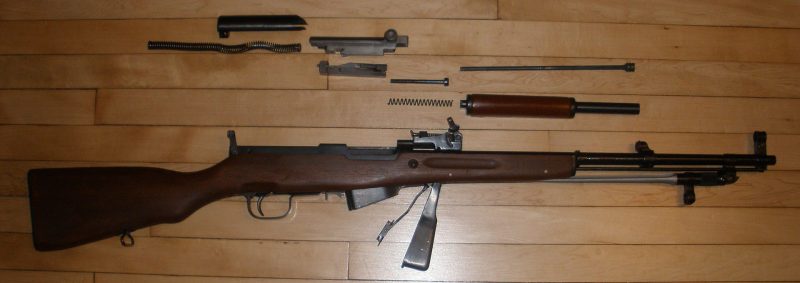
SKS carbines have been fitted with two different styles of the bayonet. The earlier type is 9″ in length and resembles a knife blade. The last type is 12″ long and is needle-shaped. Both types are attached to the barrel and fold back under the barrel when not used. The stock and handguard of the Soviet and Eastern bloc carbines are made of laminated beechwood with a hard, waterproof, clear lacquer finish.
Chinese-made SKS carbines are usually found with stocks and handguards made of porous Asian hardwood resembling teakwood and brushed with an orange-colored shellac-type finish. The Chinese SKS is sometimes fitted with a synthetic plastic resin stock and handguard, which is molded in a reddish-brown color.
The buttstock of all versions is hollowed out to receive a cleaning kit contained in a steel capsule. The body of the capsule also serves as a handle for the cleaning rod and its lid fastens over the muzzle to protect the rifle during cleaning. Inside the capsule are a bore brush, a cleaning rod extension, and a tool to clear carbon fowling from the gas port. If properly locked onto the front sight base, the capsule lid can also serve as a blank firing device.
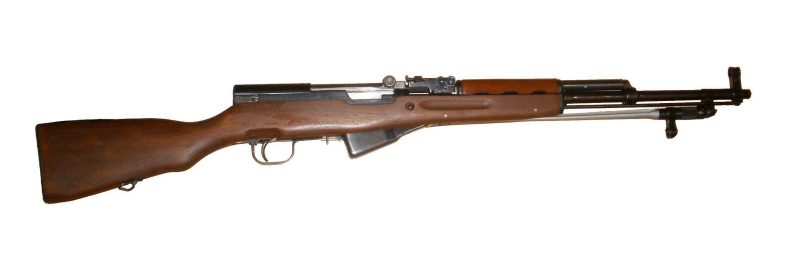
The magazine is unusual and consists of a stamped and welded sheet metal housing, stamped sheet metal floor cap, and a sheet metal follower. Both the follower arm and the floor cap are hinged to the forward end of the magazine body. A coil spring set at the hinge point furnishes sufficient pressure to the follower’s arm to ensure the feeding of cartridges.
The weapon is loaded from above with ten-round stripper clips for which a guide groove has been provided in the forward face of the bolt carrier. It is important to exert thumb pressure against the cartridges as close to the clip as possible since pressure applied elsewhere makes it difficult to strip the last three rounds. The stripper clip is a one-piece spring steel stamping – very sturdy and efficient. The magazine can also be loaded with single rounds.
Ammunition
Surplus military ammunition from Com Bloc nations is currently banned from importation. Some ammunition imported before this ban is still available. Winchester (USA) and Remington (UMC) supply military ball type ammo in 7.62×39, superior to Com Bloc ball. Trajectory data supplied here is generic and presumes a maximum point-blank range (bullet remains within 6 inches of the line of sight) of 300 yards:
| Distance (yards) | 25 | 100 | 200 | 300 | 400 | 500 |
|---|---|---|---|---|---|---|
| Trajectory (inches) | .7 | 4.7 | 2.1 | -6.1 | -26.6 | -60 |
As can be seen from the table, bullet drop makes obtaining hits with the 7.62×39 at ranges beyond 350 yards increasingly difficult. Energy loss also limits effective range.
Identifying Soviet Bloc 7.62 x 39 ammunition:
| Designation | Bullet Type | Marking | Round Weight |
|---|---|---|---|
| PS | Ball | none | 256.8 gr. |
| T-45 | Tracer | Green | 240.7 gr. |
| Z | Tracer-Incendiary | Red | 239.8 gr. |
| BZ | AP Incendiary | Black & Red | 251.5 gr. |
Variants
After World War II, the SKS design was licensed or sold to a number of the Soviet Union’s allies, including China, Yugoslavia, Albania, North Korea, North Vietnam, East Germany, Romania, Bulgaria, and Poland. Most of these nations produced nearly identical variants, with the most common modifications being different styles of bayonets and the 22 mm rifle grenade launcher commonly seen on Yugoslavian models.
Technical specifications
| Manufacturer: | Tula Arsenal, SSSR |
| Type: | Short stroke gas piston, tilting bolt, self-loading |
| Caliber: | 7.62x39mm |
| Barrel: | 520 mm (20 in) |
| Weight: | 3.85 kg (8.5 lb) |
| Magazine capacity: | 10 round stripper clip, internal box magazine |
| Cyclic rate of fire: | semi-automatic, 35-40 rounds per minute |
| Price: | $449.00 (Collection sites, March 2022) |
Timeline
| 1943 – | After reviewing several designs, the new rimless 7.62×39 medium power cartridge is adopted and named the “M43”. The Soviet weapon designer Sergi Gavrilovich Simonov converts one of his previously developed carbine designs, the SKS41 (which shot a 7.62x25mm pistol cartridge commonly used in Russian submachine guns), to utilize this new intermediate-range cartridge. |
| Spring 1944 – | Prototype models of the new SKS were shipped to the Byelorussian front for use against the Germans. |
| 1945 – | After rave reviews of the new Simonov design by soldiers, Simonov’s newest carbine is approved and dubbed the “SKS45”. |
| 1947 – | Kalashnikov’s newest design is approved and designated the “AK47”. |
| 1949 – | SKS Model 1945 is adopted by the Soviet Union. Full-scale Soviet production begins. |
| 1951 – | The AK47 enters production. In time, the SKS will be phased out as this new design incorporates select-fire, a detachable magazine, raised sights, and a pistol grip. |
| 1953 – 1954 | Production is stepped up as a second factory, Izhevsk, producing Soviet SKSs. |
| 1955 – | Soviet production of the SKS ends. |
| 1956 – | SKS production is shifted from USSR to the Peoples Republic of China (Type 56). To support the newly emerging communist regime, the USSR sends technicians to China to demonstrate |
| 1957 | Romania begins producing SKS (See the notes at bottom) |
| 1959 | Yugoslavia begins making SKS’s |
| Late 1950’s – | First, SKS’s are imported by US firms on a tiny scale. 7.62×39 ammunition was scarce in the United States until the 1980s. |
| 1964 – 1975 | Chinese Type 56 SKS rifles come to the United States in more significant numbers with troops returning from Vietnam. |
| 1986 – | Congress amends the 1968 Gun Control Act. This permits the importation of non-automatic military long guns designed before 1945. |
| 1987 – | Large-scale importation of Chinese Type 56 rifles begins due to McClure -Volkmer Act.
Yugoslavian SKS’s are imported in small quantities by Mitchell Arms for only one year. |
| 1988 – | A Chinese SKS variant is imported. Generally known as the Type 84 or SKS-D, it is designed to accept a detachable AK-47 magazine. |
| Jan 1989 – | The Roberti-Roos Assault Weapons Control Act (AWCA) becomes law and includes “SKS with detachable magazine.” At that time, there were two distinct models – one with a fixed magazine (Type 56) and one designed to accept an AK (Avtomat Kalashnikov) type detachable magazine (Type 84). The AWCA directed the Attorney General to publish an identification guide for law enforcement use. |
| Late 1989 – | Deputy Attorney General Paul Bishop is assigned to the AWCA project to deal with Office of Administrative Law-related matters. |
| 1990 – | President Bush imposes import restrictions on Chinese SKS-style rifles. Type 56 can no longer be imported if it is equipped with a bayonet, and Type 84 is prohibited. |
| Late 1990 – | Aftermarket detachable magazines become available for SKS rifles initially designed to use only a fixed magazine. |
| 1991 – | Congress further amends the 1968 Gun Control Act to import obsolete, surplus military weapons from the former communist bloc nations. |
| Jan 1991 – | Attorney General Lungren takes office. |
| Feb 1991 – | SKS definition in PC 12276 is identified as a problem by the Attorney General’s staff. Deputy Attorney General Bishop is reassigned to the AWCA project.
Attorney General’s office begins working with Senator Roberti on SB 263 to “clean up” the AWCA. |
| June 1991 – | Attorney General’s staff proposes that the SKS be deleted from AWCA via SB263. Senator Roberti opposes the Attorney General’s proposal. |
| Oct 1991 – | Governor Wilson signs SB 263, but no attempt is made to clarify the definition of SKS in PC 12276. |
| 1992 – | Deputy Attorney General Bishop convenes a group of forensic experts to produce the Assault Weapon Identification Guide and to help formulate the Attorney General’s AWCA registration policy. |
| Early 1993 – | Attorney General’s office approves the sale of Chinese SKS “Sporters,” which use “AK” detachable magazines. |
| March 1993 – | James Dingman was arrested in Santa Clara for possessing an unregistered assault weapon (Chinese Type 56 with an aftermarket detachable magazine). |
| April 1993 – | NRA requests the Attorney General’s assistance in winning the dismissal of charges against Dingman. Deputy Attorney General Bishop subsequently meets with the Santa Clara District Attorney and informs him that the Dingman firearm does not require AWCA registration. |
| April 1993 – | Assault Weapon Identification Guide (AWIG) is finally published. Dingman’s rifle is not covered. The AWIG states, “the SKS rifle was originally manufactured with a fixed 10 round magazine. However, the modified version by Norinco, which accepts a detachable AK-type magazine is an assault weapon.” |
| June 1993 – | Attorney General distributes the AWIG with information bulletin number 93-16-BCII. The bulletin notifies all California law enforcement agencies that firearms identified in the AWIG must be registered. |
| Aug 1993 – | Attorney General Lungren and Deputy Attorney General Bishop testified before the Assembly Public Safety Committee. The topic was “Implementation of the Roberti-Roos Assault Weapons Control Act.” |
| Oct 1993 – | Attorney General’s staff works with NRA to secure dismissal of charges in an “SKS with a detachable magazine” case in Nevada County.
NRA writes to the Attorney General and asks that he clarify several AWCA related issues. The Attorney General does not respond. |
| Dec 1993 – | NRA asks the Attorney General to exercise his supervisory authority over the Santa Clara District Attorney concerning the Dingman prosecution. The Attorney General does not respond.
Approximately about 950,000 SKS were imported in 1993 alone. |
| May 1994 – | Attorney General’s office refuses to accept registration for Dingman’s rifle as they contend the AWCA does not cover it. |
| Late 1994 – | Dingman was convicted of violating PC 12280(b). Dingman appeals the decision. Attorney General’s staff informs Santa Clara County that they will not handle the Dingman appeal as they don’t believe Dingman violated the AWCA. |
| Oct 1994 – | LA Times reports that President Clinton strikes a deal with Russia’s President Yeltsin for the potential importation of millions of Soviet-era firearms and billions of rounds of ammunition. As a result of that agreement, a huge number of 1950’s production Russian SKS rifles are imported by US dealers. All are equipped with bayonets. |
| May 1995 – | Two Deputy Attorney Generals (Bishop and Steve Boreman) testify before the Senate Criminal Procedure Committee in support of AB 132 (Battin). This NRA-sponsored bill would have put the Attorney General’s interpretation of the SKS issue into the AWCA. AB 132 was defeated mainly because of opposition from the Santa Clara District Attorney’s office. |
| Aug 1995 – | Attorney General’s office informs Assemblyman Granlund that their interpretation of the AWCA concerning the SKS is based on “sound legal reasoning.” |
| July 1996 – | Dingman’s conviction is upheld by the Court of Appeals for the Sixth District. |
| Aug 1996 – | Assemblyman Battin asks the Attorney General to petition the Sixth Appellate District to reconsider the Dingman case.
Dingman’s petition for rehearing is denied. Attorney General’s office asks the Sixth Appellate District to reconsider its decision in the Dingman case. Attorney General’s request is denied. |
| Sept 1996 – | Dingman appeals unsuccessfully to the California Supreme Court. |
| Sept 1996 – | Attorney General’s office asks the Supreme Court to “on its own motion order review of the Court of Appeals decision…” in the Dingman case. Chief Deputy Attorney General Stirling writes, “The impact of the court’s opinion cannot be overstated because of the millions of SKS rifles and aftermarket magazines currently in circulation. Tens of thousands of California citizens may become criminals simply by using a perfectly lawful rifle with a lawfully purchased magazine without adequate notice that such activity brings them within the proscriptions of the AWCA.” |
| Oct 1996 – | Based on the Attorney General’s request, the Supreme Court reviews the Dingman case. Such a request by the Attorney General is “unprecedented.” |
| Feb 1997 – | Attorney General files amicus brief with the Supreme Court in support of Dingman. They request that the opinion of the Court of Appeals be “reversed.” |
| Aug 1997 – | LA Times criticizes the Attorney General for his “assault weapon” failures. |
| Sept 1997 – | Attorney General withdraws his amicus brief and states that it “inaccurately reflects the view of the Attorney General.” Deputy Attorney General Bishop is reassigned after six-plus years of work on the AWCA. |
| Nov 1997 – | Attorney General informs the owners of SKS Sporters that their rifles are assault weapons and “must be relinquished to a local police or sheriff’s department.” Such rifles cannot be registered because they were purchased after June 1, 1989. |
| Dec 1997 – | Attorney General notifies licensed firearm dealers and law enforcement about his revised position on SKSs. |
| NOTES – | Estimates vary, but there may be as many as 2 million SKS rifles in the US and between three and five hundred thousand SKS rifles (Chinese and Russian) in California alone.
The Attorney Generals’ pre-September 24, 1997 interpretation of the AWCA concerning the SKS has been conveyed in numerous training sessions for peace officers, criminalists, and prosecutors during the past four years. “Aftermarket” magazines for the SKS are not interchangeable with AK-47 magazines. One year after the Chinese began manufacturing SKS’s, the Romanians started production. Two years after that, the Yugoslavians. Now I’m curious to know the start date of the Yugoslavian output. Did the Russian technicians do a “road tour” of newly emerging communist countries starting SKS production plants to shore up the governments of these new allies? |
